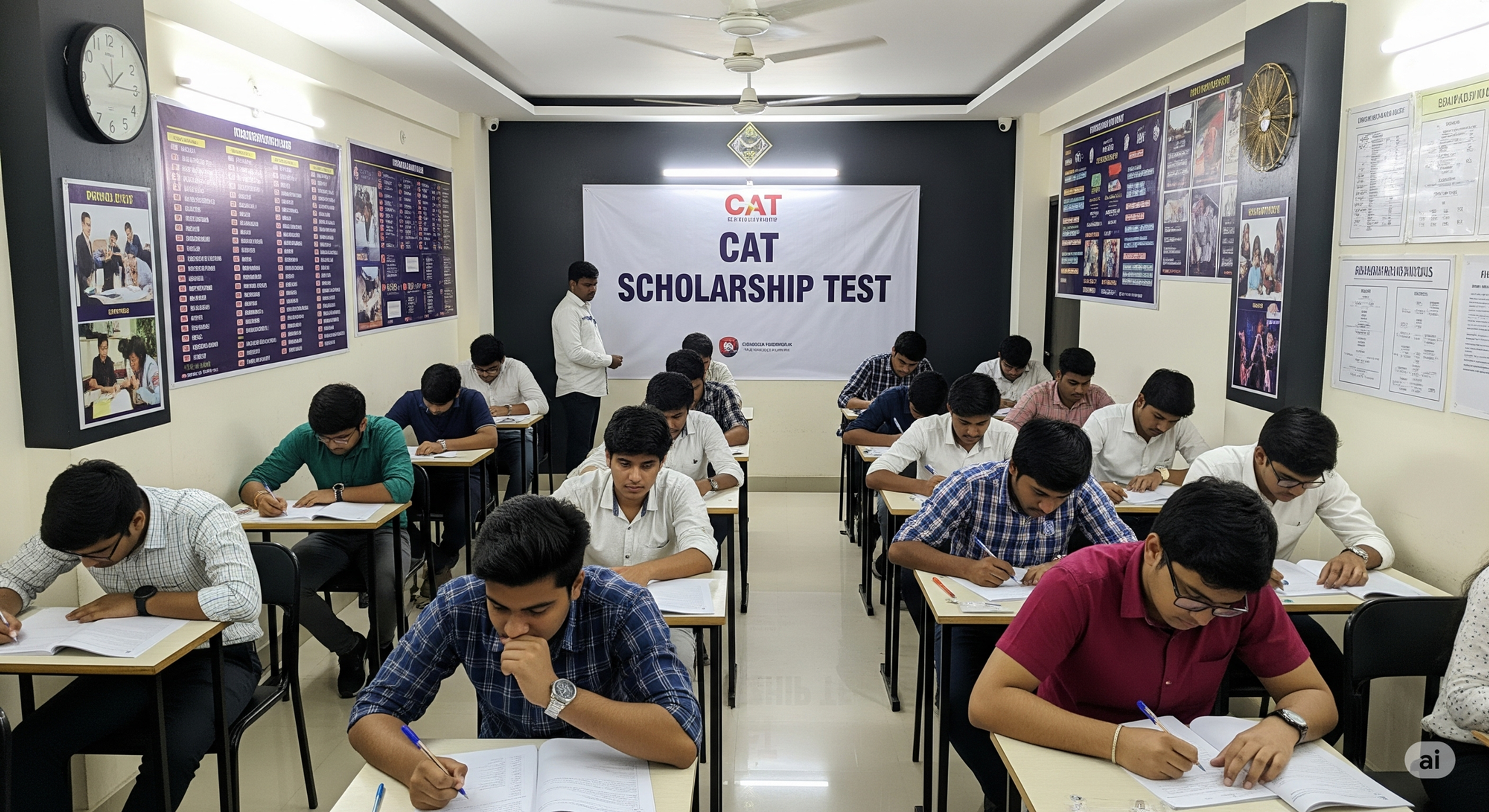CMAT 2026: Your Step-by-Step Study Plan to Success!
- Jul 31
- 5 min read

The Common Management Admission Test (CMAT) is a popular national-level entrance examination for admission to AICTE-approved management programs across India. If you're aiming for MBA admission in 2026, CMAT can be your gateway to numerous reputable B-schools. With the CMAT 2026 exam expected on January 24, 2026, and registrations commencing around November 14, 2025, now is the perfect time to kickstart your preparation!
This blog will provide you with a comprehensive, step-by-step study plan to help you ace CMAT 2026, along with answers to frequently asked questions.
Your Step-by-Step Study Plan to Success
With roughly 6 months until the exam, a structured approach is key.
Phase 1: Foundation Building (August - September 2025)
Step 1: Understand the Syllabus Thoroughly:
Go through the detailed syllabus for each section. Identify your strong and weak areas.
QA & DI: Revisit basics of Arithmetic (Percentages, Profit & Loss, Ratio & Proportion, Time & Work, Speed, Time & Distance, SI & CI), Algebra, Geometry, Number System, Modern Math, and Data Interpretation (Tables, Graphs, Charts).
LR: Focus on Analytical Reasoning, Puzzles, Series, Coding-Decoding, Blood Relations, Directions, Syllogisms, Statement-Conclusion, etc.
VERBAL : Build vocabulary (Synonyms, Antonyms, Idioms & Phrases), improve grammar (Sentence Correction, Error Spotting), and enhance reading comprehension skills.
GA: Start reading newspapers daily for current affairs (last 6-12 months are crucial). Also, cover static GK topics like History, Geography, Indian Polity, Economics, Science, Sports, and Awards.
I&E: This is a unique section. Understand basic concepts of innovation, entrepreneurship, start-up ecosystems, and government schemes. Refer to specific books for this section.
Step 2: Gather Study Material:
Collect reliable resources.
Books: Refer to standard books like "How to Prepare for Quantitative Aptitude for CAT" by Arun Sharma, "A Modern Approach to Verbal & Non-Verbal Reasoning" by R.S. Aggarwal, and specific books for Innovation & Entrepreneurship. NCERT Mathematics books for Class 8-10 are also beneficial for basic quant concepts.
Online Resources: Utilize online portals, coaching materials, and educational websites.
Step 3: Start with Basics & Build Concepts:
Dedicate separate time slots to each section.
Begin with fundamental concepts and ensure a strong grasp before moving to advanced topics.
Make concise notes of formulas, important concepts, and key facts for quick revision.
Your Step-by-Step Study Plan to Success
Phase 2: Practice & Application (October - November 2025)
Step 4: Regular Practice:
Solve chapter-wise exercises from your chosen study materials.
Focus on improving accuracy initially, then gradually work on speed.
For Language Comprehension, make reading a habit. Read diverse articles, editorials, and books to improve reading speed and comprehension.
For GA, revise your notes regularly and stay updated with current events.
Step 5: Solve Previous Year Papers: This is crucial.
Download and solve CMAT previous year's question papers with solutions. This will give you a real feel for the exam pattern, question types, and difficulty level.
Analyze the papers to identify frequently asked topics and recurring question patterns.
Step 6: Start Taking Mock Tests:
Aim for at least one mock test per week. Treat them as real exams, sticking to the time limits.
Initial mocks will help you understand your current standing and pinpoint your weakest areas.
Phase 3: Refinement & Revision (December 2025 - January 2026)
Step 7: Analyze Mock Tests Rigorously:
After each mock test, spend dedicated time analyzing your performance.
Identify questions you got wrong, questions you skipped, and areas where you spent too much time.
Understand the reasons for errors and revise those concepts.
Track your progress in terms of accuracy and speed across sections.
Step 8: Focus on Weak Areas: Dedicate more time to improving your weaker sections and topics. Don't shy away from revisiting basic concepts if needed.
Step 9: Time Management Strategy: Based on your mock test analysis, develop a personalized strategy for attempting the actual exam. Decide the order in which you'll tackle sections to maximize your score.
Step 10: Intensive Revision:
In the last few weeks, focus primarily on revising all concepts, formulas, and notes.
Avoid starting new topics right before the exam, as it can lead to confusion.
Continue taking mock tests, increasing their frequency to 2-3 per week.
The Last Few Days (Leading up to January 24, 2026)
Relax and Rejuvenate: Avoid over-studying. Get adequate sleep (7-8 hours).
Quick Revision: Glance through your notes and important formulas.
Gather Essentials: Ensure your CMAT admit card, a valid ID proof, and any other necessary documents are ready.
Visit Exam Center: If possible, visit your exam center a day before to avoid any last-minute hassle.
Stay Calm: On exam day, stay positive and confident. Manage your time wisely and attempt questions strategically.
FAQs about CMAT 2026 Preparation
Q1: Is CMAT easier than CAT/XAT?
A1: Generally, CMAT is considered to be of moderate difficulty level and is often perceived as easier than CAT or XAT. However, it's essential to not underestimate it and prepare thoroughly, especially for the unique Innovation & Entrepreneurship section.
Q2: How important is the General Awareness section in CMAT?
A2: The General Awareness section carries equal weightage (20 questions, 80 marks) as other sections. A strong performance here can significantly boost your overall score, as it's often less time-consuming if you're well-prepared.
Q3: Can I prepare for CMAT in 3 months?
A3: Yes, with a focused and disciplined approach, 3 months can be sufficient for CMAT preparation, especially if you have a decent grasp of basic concepts. Prioritize high-weightage topics, practice consistently, and take plenty of mock tests.
Q4: What are the best books for CMAT Innovation & Entrepreneurship?
A4: While there aren't many dedicated CMAT books for this section, you can refer to "Entrepreneurship & Innovation Management" by R Goal, "Entrepreneurship" by Robert D. Hisrich, and general management books. Additionally, stay updated on current business trends and government policies related to startups. Solving previous year's CMAT papers is also crucial for this section.
Q5: Are mock tests truly helpful?
A5: Absolutely! Mock tests are indispensable. They help you:
* Familiarize yourself with the exam pattern and interface.
* Improve time management skills.
* Identify your strengths and weaknesses.
* Build speed and accuracy.
* Reduce exam day anxiety.
Q6: Is there negative marking in CMAT?
A6: Yes, there is a negative marking of -1 for every incorrect answer. Unattempted questions do not incur any penalty.
Q7: What is the ideal number of mock tests to take?
A7: Aim for at least 15-20 full-length mock tests. More is always better, especially in the last two months leading up to the exam. Consistent analysis of these mocks is even more important than the number of tests taken.
Q8: When does CMAT registration usually start?
A8: CMAT registration for 2026 is expected to start around November 14, 2025, and typically continues until December 25, 2025. Keep an eye on the official NTA CMAT website for precise dates.
By following this comprehensive study plan and staying consistent with your efforts, you can significantly increase your chances of cracking CMAT 2026 and securing admission to your dream MBA program.
Good luck!






Comments